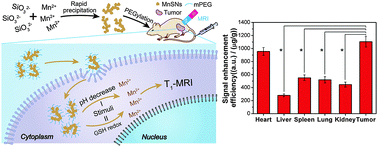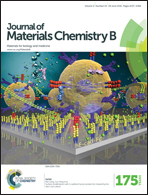Facile synthesis of manganese silicate nanoparticles for pH/GSH-responsive T1-weighted magnetic resonance imaging†
Abstract
Contrast agents (CAs) play an important role in enhancing the magnetic resonance imaging (MRI) performance for accurate tumor diagnosis, which, however, may give rise to unexceptional issues such as in vivo accumulation and bio-toxicity. Here we report on manganese silicate nanoparticles (denoted as MnSNs) as highly biocompatible and pH/GSH-responsive T1-weighted MRI CAs. The MnSNs were synthesized via a facile, cost-effective and environmentally friendly route based on one-step rapid precipitation between the Mn2+ cation and the SiO32− anion in aqueous solution at room temperature without any other additives, and showed excellent dispersion stability in water or PBS for weeks without any surface modification at ambient temperature. The MnSNs present an efficient pH/GSH-responsive T1-MRI feature based on the rapid changes in the relaxation rate in a mildly acidic/reducing environment both in vitro and in vivo, and furthermore, MnSNs showed negligible cellular cytotoxicity in vitro, no distinct tissue toxicity in vivo and fast clearance from the body organs and tissues in 24–72 h. Thus, the MnSNs are able to serve as a novel class of highly promising T1-MRI CAs for clinical cancer diagnosis.


 Please wait while we load your content...
Please wait while we load your content...